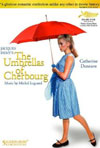
France 1964
Directed by
Jacques Demy
92 minutes
Rated G
Reviewed by
Bernard Hemingway


The Umbrellas Of Cherbourg
Les Parapluies de Cherbourg, which won Best Film at Cannes the year of its release, comes up with regularity in film buffs' lists of favourites, less I would believe because of easily-won satisfactions than because of its remarkably daring choice of having the dialogue entirely sung (to music by Michel Legrand).
The visuals are wonderfully late 1950s/early '60s in what is a peculiarly Gallic homage to the Hollywood musical. Like opera, it's not for everybody, but you should see it at least once. In making the film Demy decided to sacrifice print longevity for vibrant colour and though the stock he used gave him brilliantly saturated hues it degraded quickly. The director, anticipating this problem, had archived multiple monochromatic negatives which, when combined with each other, allowed re-creation of the original color. Under the supervision of Agnes Varda, Demy's widow (the director died in 1990), in 1992 the film was remastered and fortunately is now preserved in digital form.
Les Parapluies is also exceptional (Demy did follow it in 1967 with a less-successful stylistically similar 1967 sequel, Les Desmoiselles De Rochefort, which also starred Deneuve) in the musical genre in that although clearly enamoured of films like Singin' In The Rain (1952) whose most famous scene involves Gene Kelly and an umbrella, it is not so much a collection of show tunes interspersed with dialogue as one expanded song. For some, the lack of musical variety may be a little difficult to take, particularly as there are no big production numbers or even any dancing, although others will be seduced by the gorgeous production design and the equally gorgeous Deneuve (then 21) as the 17-year old Genevieve.
In a classic scenario of star-crossed love Genevieve works in her mother’s umbrella shop (a delightful index of a world long gone) and is madly in love with 20-year old motor mechanic Guy (Nino Castelnuovo). Guy gets called up for the army, Genevieve falls pregnant after a one-night stand, eventually succumbs to her mother's aspirations, marries a wealthy bourgeois (the Roland Cassard character appears in Demy's 1961 film, Lola) and moves away. Guy returns, is heartbroken, marries his godmother's carer and such is life.
For all the incomparable fruitiness of the film, my favourite scene is the final beautifully simple one all white with accents of red, set at night in front of Guy’s snow-covered Esso garage where the two former lovers meet briefly and bravely before going their separate ways in the night whilst Legrand’s music surges in the background. Superbe!
Want something different?





